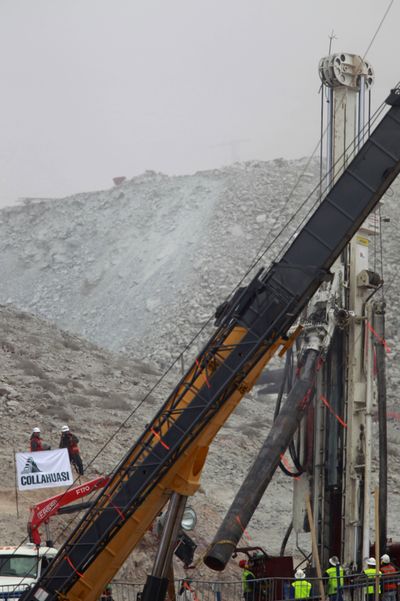Miners’ final hours tense
Officials closely watching physical, mental states

SAN JOSE MINE, Chile – A smooth-walled path to daylight awaited 33 trapped miners Sunday as they entered the tense final hours of a two-month odyssey christened in the terror of collapsing rock deep under a Chilean mountain.
With the eyes of the world on Chile’s no-expense-spared effort to ensure all the men emerge unharmed, the miners’ physical and mental health was being fastidiously monitored. Precautions were taken against all manner of complications – aspirin to prevent blood clots, a special drink to settle the stomach, video monitors to watch for panic attacks.
And officials said the men were so giddy with confidence they were squabbling on Saturday, the day drills broke through to them, over who would get to be the last to take a twisting, 20-minute ride the half-mile up to a rock-strewn desert moonscape and into the embrace of those they love.
A tentative but secret list was drafted of which miners should come out first when the extraction begins, probably on Wednesday. But Health Minister Jaime Manalich said the otherwise cooperative miners were so sure of the exit plan that they were arguing about sequence.
“They were fighting with us yesterday because everyone wanted to be at the end of the line, not the beginning,” he told reporters.
Manalich told the Associated Press that a few had volunteered in conversations among themselves to go up first. But none had volunteered publicly, he said.
The final order will probably be determined by two paramedics, one from the navy and one from the Codelco state mining company, who will be lowered into the mine to prepare the men for their journey in a rescue capsule built by Chilean naval engineers.
Over the past week, all the miners underwent tests to assess their health. Manalich said officials were concerned about acute hypertension in some of the miners as well as the opposite – sudden drops in blood pressure – in others because of the speed of the ascent to the surface.
Another concern is blood clotting. To counteract it, the miners began taking 100 milligrams each of aspirin on Sunday, he said. They will also put on compression socks and a special girdle and will be on a special high-calorie liquid prepared and donated by NASA for the final six hours before being removed, Manalich said.
The liquid-only diet is to prevent them from becoming nauseated. The rescue capsule is expected to rotate 350 degrees some 10 to 12 times through curves in the 28-inch-diameter escape hole on its way up, he added.
Officials’ biggest worry was panic attacks, the health minister said.
“They are very nervous. But on the other hand they’re so busy with what’s happening,” he said. “There’s no time to think or be distracted.”
The miners will also wear sweaters because they’ll experience a shift in climate from about 90 degrees Fahrenheit underground to temperatures hovering near freezing if they emerge at night. And those coming out during daylight hours will wear sunglasses.
After a quick on-site medical check, they will be helicoptered to a hospital 15 minutes away where they will be put under observation in a ward dark as a movie theater.